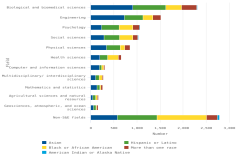Report
Executive summary
Doctoral education trains scientists, engineers, researchers, and scholars, all of whom are critical to the nation’s progress. These individuals create and share new knowledge and new ways of thinking that lead, directly and indirectly, to new products, services, and works of art. Annual counts of doctorate recipients from U.S. universities are measures of the incremental investment in human resources devoted to science, engineering, research, and scholarship, and these counts can serve as leading indicators of the capacity for knowledge creation and innovation in various domains.
Changes in the characteristics of this population over time reflect political, economic, social, technological, and demographic trends. These include the following:
- Changes in representation of doctorate recipients in different demographic groups
- Growth in science and engineering (S&E) fields and changes in their relative size
- Shifting academic employment opportunities after graduation
- Trends in the pursuit of postdoctoral research positions by field
Understanding these connections is necessary to inform policy discussions regarding this country’s doctoral education system.
The data in this report cover the 2023 academic year (1 July 2022 to 30 June 2023) and were collected from doctorate students who completed the Survey of Earned Doctorates (SED) as they approached graduation.
Key takeaways from the 2023 SED data include the following:
- The number of doctorate recipients from U.S. universities increased from 57,448 in 2022 to 57,862 in 2023. This small increase contrasted with the sharp 1-year increase (10%) in 2022, which followed 2 years of decline due to the COVID-19 pandemic. This suggests that the number of doctorate recipients from U.S. universities may have stabilized following the onset of the pandemic.
- Between 2022 and 2023, the number of U.S. citizen and permanent resident doctorate recipients increased by 1% to 35,566. The number of doctorate recipients who were temporary visa holders decreased by 1% to 19,393 due to a decline in their numbers in S&E fields.
- A higher proportion of doctorate recipients indicated that the pandemic had disrupted their research in 2023 (70%) than in previous years (48% in 2021 and 67% in 2022). Of those who reported that the pandemic had disrupted their research in 2023, 81% indicated that the disruptions stemmed from having limited or no access to resources needed for research.
- In 2023, 54% of doctorate recipients indicated that the timeline for completing their doctoral degree was delayed by the pandemic, similar to the 53% who reported a delayed degree in 2022 and higher than the 39% in 2021. Ten percent of doctorate recipients said funding for their doctoral studies had been reduced or suspended, a slight decrease from 2022 (12%).
- In 2023, the proportion of S&E doctorate recipients with definite postgraduation commitments was the highest in psychology (80%) and the lowest in biological and biomedical sciences (68%). Biological and biomedical sciences was the only S&E field with a lower proportion of definite commitments in 2023 than in 2003 (72%).
- In 2023, engineering had the lowest proportion (10%) of doctorate recipients with non-postdoc academic employment commitments. Conversely, engineering had the highest proportion of non-postdoc industry or business commitments (80%) and was the only field to have a higher proportion in 2023 than in 2022 (79%).
- Between 2022 and 2023, the postdoctoral study (postdoc) commitment rate declined in most fields. The largest decline was in agricultural sciences and natural resources (from 50% in 2022 to 46% in 2023).
 An official website of the United States government
An official website of the United States government


















